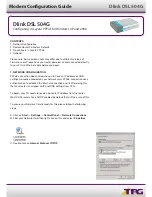
AT Commands
Powering-up the Modem
When power is applied to the OMEGA CDMA Modem, observe the modem LEDs. If switch 5 is
set to ON, the
Power
,
CTS
, and
DSR
LEDs should all go ON after the modem performs its
initialization for approximately 30 seconds. The
RTS
,
DCD
,
TXD
, and
RXD
LEDs go ON when
a DTE is connected to the modem, a connection is established, and data is being transferred.
Note:
If the OMEGA CDMA Modem is not registered with the cellular network, the DSR
LED will be OFF.
Call Answer Testing
After powering-on the OMEGA CDMA Modem, use the following procedure to test the
modem’s ability to answer a call.
1.
Use a telephone to call the OMEGA CDMA Modem. Listen to the call to verify that the
OMEGA CDMA Modem answers the call with its answer tone and performs its handshaking
sequence in an attempt to make a data connection. Hang up the handset of the telephone that
originated the call.
2.
Use another modem to call the OMEGA CDMA Modem. Verify that the OMEGA CDMA
Modem answers the call, makes a data connection, and turns on the
DCD
LED. If the
DCD
LED does not go ON, make sure switch 5 is in the ON position to monitor RS-232 signals.
Configuring the OMEGA CDMA Modem
The OMEGA CDMA Modem is configured by issuing AT commands from a DTE connected to
the OMEGA CDMA Modem’s serial port. Commands are sent using a terminal-emulation
software program such as HyperTerminal. The terminal-emulation program must be configured
to use the following settings:
Baud rate: use the baud rate selected by Switches 1 and 2 on the OMEGA CDMA Modem
(see Table 2-3 on page 14)
Data bits: 8
Parity bit: none
Page 16
















































